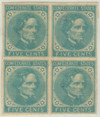
# CSA6 - 1862 5c Confederate States - Jefferson Davis - lt blue, hard paper (De La Rue & Co)
Birth Of Jefferson Davis
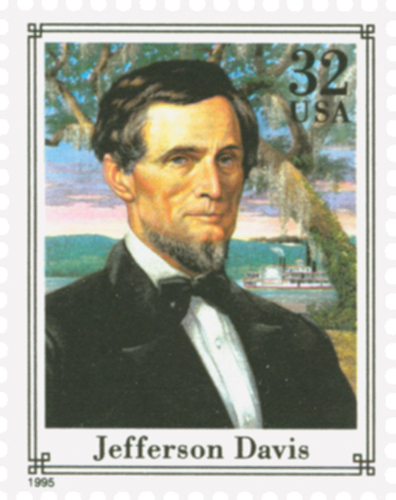
Jefferson Davis was born on June 3, 1808, in Fairview, Kentucky, though he grew up in Wilkinson County, deep in Mississippi’s cotton country.
Davis entered West Point in 1824. Two years later, he was placed under house arrest for his involvement in the “Eggnog Riot.” Following graduation, he served under Zachary Taylor and became smitten with Taylor’s daughter, Sarah. Taylor was against the courtship and didn’t attend their wedding. His animosity grew three months later when the young couple contracted malaria while visiting Davis’ sister in Louisiana. Jefferson survived; Sarah did not.
Stricken with grief, Davis retreated to a 900-acre plot his brother Joseph gave him, where he built Brierfield Plantation in 1847. Ten years later, he owned 74 slaves. Davis’ slaves were educated and well fed in an era when teaching African-Americans was discouraged and brutality common. They were given a degree of self-governance and allowed to settle matters of discipline in courts made of their peers.
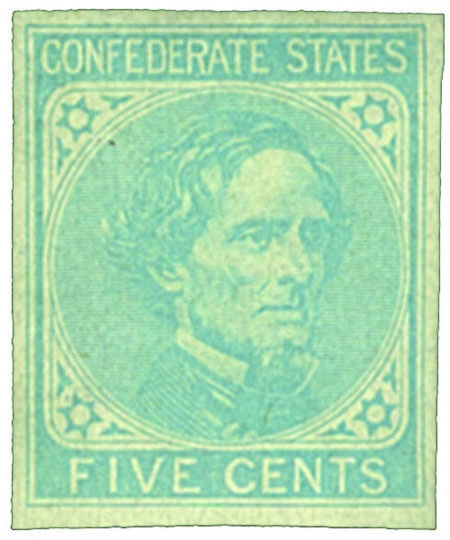
During this period, Davis became involved in politics, serving as a delegate to the Democratic state convention and campaigning for James K. Polk. He also remarried, selecting Varina Howell as his bride. The couple would have six children, although only one lived to marry and raise a family.
Davis raised a volunteer regiment at the outbreak of the Mexican-American War and served as its colonel under commanding General Zachary Taylor. His troops participated in the siege of Monterrey and the Battle of Buena Vista, where he was shot in the leg. Learning of Davis’ bravery, Taylor is alleged to have said, “My daughter, sir, was a better judge of men than I was.”
Davis was appointed to temporarily fill a vacant Mississippi Senate seat in 1847, and was later elected to it. The Smithsonian Institution also appointed him a regent during this time. Each of these honors stemmed largely from Davis’ distinguished military service.
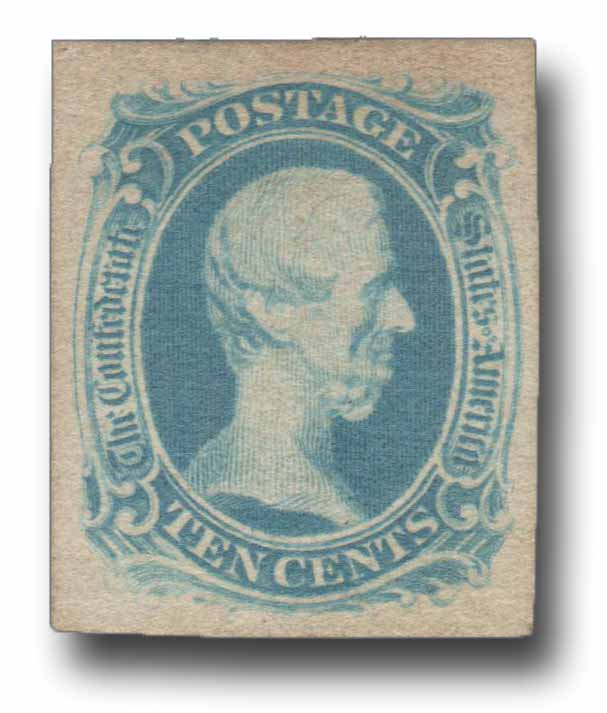
As a senator, Davis introduced several amendments to the Treaty of Guadalupe Hidalgo, which sought unsuccessfully to annex northwestern Mexico. He also declared Cuba “must be ours” to “increase the number of slaveholding constituencies. Opposed to the Compromise of 1850, Davis resigned to run for the governorship of Mississippi, but lost the election.
Left without a political office, Davis took part in a states’ rights convention and campaigned throughout the South for Democratic presidential candidate Franklin Pierce. He was rewarded with an appointment to serve as U.S. secretary of war following Pierce’s election. Davis pushed for the Gadsden Purchase of today’s southern Arizona from Mexico, increased the Army from 11,000 to 15,000 troops, and modernized its weaponry. He also oversaw the building of the Capitol Dome. When Pierce lost his bid for re-election in 1857, Davis resumed his own career in the Senate.
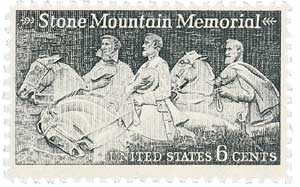
On July 4, 1858, Davis delivered an anti-secessionist speech near Boston – a platform he would repeat in October. As he explained after the Civil War, Davis felt each state was sovereign and had the right to secede. But he didn’t believe the North would allow a peaceful separation and urged the South to delay secession for that reason. Davis also knew the South lacked the military and naval resources to defend itself. Lincoln’s election and the rapid declarations of secession sealed Davis’ fate, and he delivered a farewell address to the U.S. Senate on January 21, 1861. He would call that day the saddest in his life.
Davis told the governor of Mississippi he would do whatever the state required of him. On January 23, he was made major general of the Army of Mississippi. Then in early February, the Confederacy held a constitutional convention, which selected Davis as its new president. Davis received the news via telegraph and according to his wife, “looked so grieved that I feared something had befallen our family. He told me (of his appointment) as a man might speak a sentence of death.” Davis was inaugurated on February 18 in front of 5,000 people cheering with patriotic zeal. Looking out over them, Davis recalled, “I saw smiling faces, but beyond them I saw troubles and thorns innumerable.”

Davis had been a staunch defender of slavery in the years building up to the Civil War, but preferred to avoid both secession and war. He spent the first six weeks of his presidency trying to negotiate peacefully with Northern officials until talks broke down over Fort Sumter. Only then did Davis give the order to fire on the Federal fort.
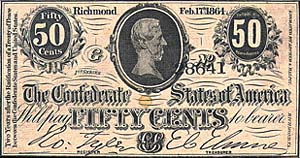
Early on, Davis displayed the characteristics that doomed his leadership, the largest being his reluctance to delegate authority and a dependence on old cronies. Flawed military strategy and insensitivity to the suffering of his followers also hampered Davis’ administration.
Captured on May 10, 1865, Davis spent two years in prison before being released on a bond of $100,000, which was raised by a group of prominent citizens including Horace Greeley, Cornelius Vanderbilt, and abolitionist Gerrit Smith. While he became a symbol of the Confederate “Lost Cause,” Davis urged loyalty to the nation during Reconstruction. Following his death on December 6, 1889, Davis’ funeral, which was one of the largest in the South, included a continuous procession from New Orleans to Richmond.
Davis had outlived the Confederacy, buried all four of his sons, and witnessed his daughter’s engagement to a Yankee from New York. Yet he remained unapologetic to the end. “Were the thing to be done over again, I would do as I then did. Disappointments have not changed my conviction.”
Birth Of Jefferson Davis

Jefferson Davis was born on June 3, 1808, in Fairview, Kentucky, though he grew up in Wilkinson County, deep in Mississippi’s cotton country.
Davis entered West Point in 1824. Two years later, he was placed under house arrest for his involvement in the “Eggnog Riot.” Following graduation, he served under Zachary Taylor and became smitten with Taylor’s daughter, Sarah. Taylor was against the courtship and didn’t attend their wedding. His animosity grew three months later when the young couple contracted malaria while visiting Davis’ sister in Louisiana. Jefferson survived; Sarah did not.
Stricken with grief, Davis retreated to a 900-acre plot his brother Joseph gave him, where he built Brierfield Plantation in 1847. Ten years later, he owned 74 slaves. Davis’ slaves were educated and well fed in an era when teaching African-Americans was discouraged and brutality common. They were given a degree of self-governance and allowed to settle matters of discipline in courts made of their peers.

During this period, Davis became involved in politics, serving as a delegate to the Democratic state convention and campaigning for James K. Polk. He also remarried, selecting Varina Howell as his bride. The couple would have six children, although only one lived to marry and raise a family.
Davis raised a volunteer regiment at the outbreak of the Mexican-American War and served as its colonel under commanding General Zachary Taylor. His troops participated in the siege of Monterrey and the Battle of Buena Vista, where he was shot in the leg. Learning of Davis’ bravery, Taylor is alleged to have said, “My daughter, sir, was a better judge of men than I was.”
Davis was appointed to temporarily fill a vacant Mississippi Senate seat in 1847, and was later elected to it. The Smithsonian Institution also appointed him a regent during this time. Each of these honors stemmed largely from Davis’ distinguished military service.

As a senator, Davis introduced several amendments to the Treaty of Guadalupe Hidalgo, which sought unsuccessfully to annex northwestern Mexico. He also declared Cuba “must be ours” to “increase the number of slaveholding constituencies. Opposed to the Compromise of 1850, Davis resigned to run for the governorship of Mississippi, but lost the election.
Left without a political office, Davis took part in a states’ rights convention and campaigned throughout the South for Democratic presidential candidate Franklin Pierce. He was rewarded with an appointment to serve as U.S. secretary of war following Pierce’s election. Davis pushed for the Gadsden Purchase of today’s southern Arizona from Mexico, increased the Army from 11,000 to 15,000 troops, and modernized its weaponry. He also oversaw the building of the Capitol Dome. When Pierce lost his bid for re-election in 1857, Davis resumed his own career in the Senate.

On July 4, 1858, Davis delivered an anti-secessionist speech near Boston – a platform he would repeat in October. As he explained after the Civil War, Davis felt each state was sovereign and had the right to secede. But he didn’t believe the North would allow a peaceful separation and urged the South to delay secession for that reason. Davis also knew the South lacked the military and naval resources to defend itself. Lincoln’s election and the rapid declarations of secession sealed Davis’ fate, and he delivered a farewell address to the U.S. Senate on January 21, 1861. He would call that day the saddest in his life.
Davis told the governor of Mississippi he would do whatever the state required of him. On January 23, he was made major general of the Army of Mississippi. Then in early February, the Confederacy held a constitutional convention, which selected Davis as its new president. Davis received the news via telegraph and according to his wife, “looked so grieved that I feared something had befallen our family. He told me (of his appointment) as a man might speak a sentence of death.” Davis was inaugurated on February 18 in front of 5,000 people cheering with patriotic zeal. Looking out over them, Davis recalled, “I saw smiling faces, but beyond them I saw troubles and thorns innumerable.”

Davis had been a staunch defender of slavery in the years building up to the Civil War, but preferred to avoid both secession and war. He spent the first six weeks of his presidency trying to negotiate peacefully with Northern officials until talks broke down over Fort Sumter. Only then did Davis give the order to fire on the Federal fort.

Early on, Davis displayed the characteristics that doomed his leadership, the largest being his reluctance to delegate authority and a dependence on old cronies. Flawed military strategy and insensitivity to the suffering of his followers also hampered Davis’ administration.
Captured on May 10, 1865, Davis spent two years in prison before being released on a bond of $100,000, which was raised by a group of prominent citizens including Horace Greeley, Cornelius Vanderbilt, and abolitionist Gerrit Smith. While he became a symbol of the Confederate “Lost Cause,” Davis urged loyalty to the nation during Reconstruction. Following his death on December 6, 1889, Davis’ funeral, which was one of the largest in the South, included a continuous procession from New Orleans to Richmond.
Davis had outlived the Confederacy, buried all four of his sons, and witnessed his daughter’s engagement to a Yankee from New York. Yet he remained unapologetic to the end. “Were the thing to be done over again, I would do as I then did. Disappointments have not changed my conviction.”





